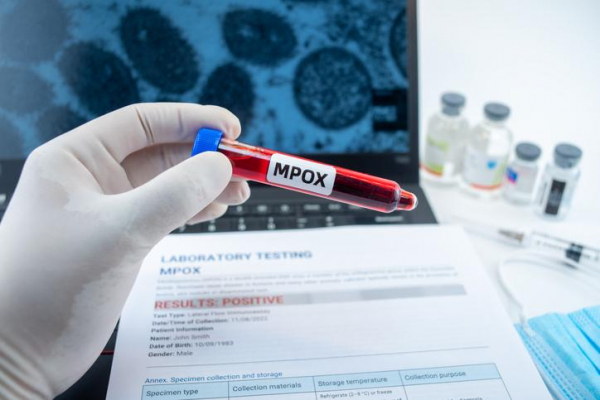
Protect your skin during heat waves — here’s how

Global average temperatures have soared in 2024, surpassing records set just last year. Extreme heat poses numerous health risks, some of which are visible on our skin. Understanding how heat affects your skin can help you take measures to prevent or ease heat rash, eczema, rosacea, the discoloration of melasma, and many other skin conditions sparked or worsened by high temperatures.
How does heat affect your skin?
Heat waves can provoke or worsen several skin conditions.
- Heat rash (miliaria) occurs due to obstruction of sweat ducts on the skin, which are responsible for helping the body maintain a normal temperature by releasing water to the surface of the skin. As these sweat glands get blocked with excessive sweat on an extremely hot day, they do not function properly and red itchy bumps develop.
- Grover disease, a rash of small, red, itchy bumps on the chest and back, can also be triggered or worsened by excessive heat and sweating. Often this clears up within a few weeks or months. Less often symptoms may persist for years, with flares during the summer months.
- Eczema is a chronic skin condition characterized by dry, itchy plaques that affects millions of people in the United States. Increased sweating during heat waves can lead to skin irritation and inflammation, aggravating eczema symptoms. Dehydration caused by fluid loss through sweating can make the skin more susceptible to eczema flare-ups.
- Rosacea, which causes facial redness, visible blood vessels, and acne-like bumps, is also heat-sensitive. Heat causes blood vessels to dilate as the body attempts to cool itself, resulting in visible redness and flushing. High temperatures, especially combined with sun exposure, can cause flare ups.
- Melasma. Hyperpigmentation disorders like melasma also worsen with heat. Melasma is characterized by irregular dark patches on the face and is often triggered by UV exposure from the sun. Heat can increase the activity of melanocytes, the cells that produce pigment, making these patches more pronounced. Additionally, the combined effects of heat and UV radiation accelerate collagen and elastin degradation, leading to premature aging and loss of skin elasticity.
- Skin cancer risk rises with increased exposure to UV radiation. Heat waves — now beginning earlier, ending later, and lasting longer — contribute to UV exposure, particularly among people who work outdoors. And preliminary research suggests prolonged exposure to high temperatures may further boost skin cancer risk. This could be of particular concern for firefighters, who face extended exposure to extreme heat.
Heat waves, air pollution, and skin
During heat waves, levels of environmental pollutants like ozone and particulate matter can rise. And reactions between these pollutants, heat, and UV radiation spawn secondary pollutants such as peroxyacetyl nitrates (PANs). Pollutants like these can irritate the skin and contribute to inflammation through oxidative stress and DNA damage, so inflammatory conditions such as eczema and rosacea may worsen.
Can heat affect medications?
High temperatures compromise the effectiveness of certain medications. For instance, EpiPens, which are crucial for managing life-threatening allergic reactions, can lose their potency when exposed to high temperatures. Check the instructions on all of your medicines to see which ones should be stored in a cool, dry place or refrigerated. If you’re not sure which medicines might be affected by heat, talk to your pharmacist or doctor.
Retinoids in skin care products, antibiotics taken for acne, and immunomodulators for autoimmune diseases can make skin more susceptible to sun damage. This can lead to severe sunburns or rashes known as photodermatoses. If you experience this, contact your health care team for advice.
Protect your skin when temperatures climb
Keep skin cool
- Wear light, breathable clothing. Choose natural fibers like cotton and linen to help regulate body temperature and prevent sweat-induced skin issues. Avoid synthetic fabrics, which can trap heat and moisture.
- Take cool baths or showers. Use cool or tepid water to bathe. Avoid hot showers, which can strip the skin of natural oils, leading to dryness and irritation.
- Find cool spaces. If your home is not air-conditioned, seek out cooler places and ways to cool off during heat waves.
Keep skin hydrated
- Drink ample water and eat water-rich foods. Foods like watermelon and cucumbers can provide additional hydration.
- Moisturize your skin. Apply light, non-comedogenic moisturizers immediately after bathing. Look for ingredients such as hyaluronic acid and glycerin, which are beneficial for enhancing skin hydration.
Limit exposure to sun and pollution
- Use protective clothing. Wear wide-brimmed hats, UV-blocking sunglasses, and long-sleeved shirts to shield the skin from harmful radiation.
- Wear sunscreen. Apply broad-spectrum mineral sunscreens containing zinc oxide, titanium dioxide, or iron oxide to protect against UV radiation and pollutants.
- Use topical antioxidants. Use products like vitamin C in your morning skin care routine to mitigate oxidative stress.
- Wash up. Cleansing face and body at the end of the day may help you limit skin exposure to pollutants while also rinsing off any sunscreen residue.
About the Authors

Kathyana P. Santiago Mangual, Contributor
Kathyana P. Santiago Mangual is a clinical research fellow in dermatology at Massachusetts General Hospital and Harvard Medical School. She is also a medical student at the University of California, Los Angeles, and will be graduating … See Full Bio View all posts by Kathyana P. Santiago Mangual 
Arianne Shadi Kourosh, MD, MPH, Contributor
Arianne Shadi Kourosh, MD, MPH, is a board certified dermatologist and associate professor of dermatology at Harvard Medical School. She is a graduate of the Harvard T.H. Chan School of Public Health and the University of … See Full Bio View all posts by Arianne Shadi Kourosh, MD, MPH

Mpox is back: What to know and do

Ever heard of mpox? Wondering why it’s back in the news?
Many of us first learned about mpox (formerly called monkeypox) in 2022, when the largest known outbreak spread to nearly 100,000 people in more than 100 countries. While mpox often circulates in central and western Africa, the 2022 outbreak quickly spread from the Democratic Republic of the Congo (DRC) to places it had never been detected before. In the US alone, it caused more than 32,000 infections and 58 deaths.
Now, a new outbreak of mpox has put it back in the news. What should you know — and do — about this latest international health emergency? What are your risks? Are vaccines available? If you get mpox, how can you avoid spreading it?
What’s different about the 2024 mpox outbreak?
This time, a new strain of the virus (called Clade 1b) is spreading quickly. That’s why the World Health Organization (WHO) declared a second mpox global health emergency in August 2024.
Already, more than 15,600 cases and 500 deaths have been reported, mostly in the DRC. And mpox has been found in countries that previously hadn’t identified any cases, including Burundi, Kenya, Rwanda, and Uganda. Recent cases diagnosed in Sweden and Thailand have public health officials bracing for additional international spread, including to Asia, Europe, and the US.
6 things to know about mpox
What is mpox and how does it spread?
Mpox is a viral infection caused by the same family of viruses as smallpox. In central and western Africa it’s common in certain animals, including squirrels and rats. People can become infected after contact with infected animals. Mpox can spread from person to person through close physical contact, including sex.
What are the symptoms of mpox?
Mpox causes flulike symptoms, fever, headache, enlarged lymph nodes, and a unique rash. The rash usually begins a few days into the illness as small flat spots. The spots evolve over a week or two to become small fluid-filled bumps (vesicles) similar to chickenpox, and then larger pus-filled blisters. Over another week or two, the blisters scab over and heal. Once that happens, a person is no longer contagious.
Although the disease is usually mild, some people develop complications. Serious complications include pneumonia, vision loss due to eye infection, and sepsis, a life-threatening infection.
What is your risk of getting mpox?
Location and activities factor into your risk for developing mpox.
Risk increases if you
- have close physical contact with an infected animal or person
- have contact with bedding, clothes, or other objects or surfaces touched by an infected person
- live in or visit a place where the mpox virus is endemic — that means present in the environment, such as in the soil or infected animals or people
- are a man who has sex with men
- have many sexual partners.
When people get mpox, risk factors for experiencing more severe disease or complications like pneumonia include:
- pregnancy
- young age (especially children younger than age 1)
- having a weakened immune system
- having eczema (because this weakens the protective skin barrier).
Why is the new mpox outbreak so worrisome?
The new outbreak of mpox is especially worrisome because the strain of the virus is deadlier than in 2022. The virus is spreading more quickly and reaching places where mpox had not previously been found.
In addition, the new outbreak has disproportionately affected kids and teens in resource-poor countries. Many are already suffering with malnutrition, or other infections such as cholera.
It’s worth noting that the strain of mpox from the 2022 outbreak (Clade 1) is still circulating at a low level in the US. Right now, fewer than 15 people a week are diagnosed with it and treatment is available.
Are there mpox vaccines and treatments?
There are two vaccines available to prevent mpox in the US:
- Jynneos is approved to prevent mpox and smallpox. It requires two doses four weeks apart.
- A vaccine called ACAM2000 is approved for preventing smallpox and is considered effective for mpox. It could be made available if needed, but its potential side effects make it a second choice.
Resource-poor countries in Africa, Asia, and elsewhere have had limited access to vaccines. Even in resource-rich countries like Europe and the US, vaccine hesitancy has been an obstacle to containing the outbreak. In one study, only half of a vulnerable population in Illinois received the initial dose of the mpox vaccine, and only a quarter received both recommended doses.
An antiviral drug called tecovirimat is approved to treat smallpox. Animal studies suggest it may be effective in treating mpox as well. Now being investigated as an mpox treatment, the drug may be available by enrolling in a study. A 2024 study found tecovirimat did not reduce the length of time adults and children with Clade 1 mpox had symptoms. However, the death rate (1.7%) was half of what was expected. But it’s unclear whether the low death rate was actually due to drug treatment.
How can someone with mpox avoid spreading it?
If you are diagnosed with mpox, it’s important to take these measures to avoid infecting others:
- Avoid close contact with others until your skin lesions have healed.
- Wear a well-fitting medical mask while near others; those visiting you should wear a mask as well.
- Stay several feet or more away from others.
- Use a separate bedroom and bathroom.
- Clean all surfaces you’ve touched.
- Don’t share eating utensils, towels, or bedding with others.
- Increase room ventilation by opening windows or using a high-efficiency particulate air (HEPA) purifier.
Some experts recommend avoiding contact with pets or other animals because they could become infected and spread the disease to new animal species in new places.
The bottom line
Will mpox be the next pandemic? That’s unlikely. The virus that causes mpox spreads mainly by direct contact — unlike the virus that causes COVID-19, which spreads through small respiratory droplets that are easily breathed in. Also, people with mpox who are contagious typically have obvious symptoms, so they can take steps to avoid spread.
Currently, the risk mpox poses to most people in the US appears to be quite low. To help make sure it stays that way and to help countries where mpox is common, US public health officials are working with their counterparts in other countries to contain the outbreak. To be successful, we’ll need a robust. well-coordinated international effort, including financial support to resource-poor countries to fund educational programs, vaccination, testing, and treatment.
About the Author

Robert H. Shmerling, MD, Senior Faculty Editor, Harvard Health Publishing; Editorial Advisory Board Member, Harvard Health Publishing
Dr. Robert H. Shmerling is the former clinical chief of the division of rheumatology at Beth Israel Deaconess Medical Center (BIDMC), and is a current member of the corresponding faculty in medicine at Harvard Medical School. … See Full Bio View all posts by Robert H. Shmerling, MD